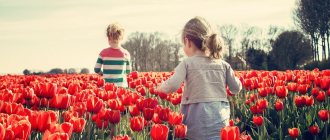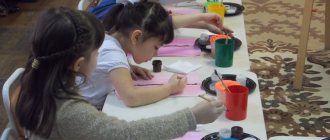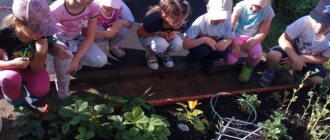Municipal budgetary preschool educational institution, kindergarten of general developmental type No. 11 “Firefly” of the Municipal Entity Timashevsky District (MBDOU d/s No. 11) was opened in 1966.
If there is an island of love, joy, and happiness on Earth, then this is MBDOU d/s No. 11 “Firefly”. Our preschool educational institution is a living organism that breathes, feels, and rejoices. We try to penetrate every child's heart, instill in it joy, love, kindness. Preschool educational institutions are parents. They are the main assistants in our work and we are very grateful to them for this. Preschool educational institutions are employees. The most hardworking, creative people who can do everything, who care about everything with their souls, who love children. A preschool is a big family. And like any friendly family, we have our own traditions. If you want your baby to feel comfortable, to develop in accordance with his capabilities and abilities, come to us at the Firefly kindergarten.
The preschool educational institution operates in accordance with the Federal Law “On Education in the Russian Federation”. A license was issued for the right to carry out educational activities under educational programs dated March 12, 2013 No. 05353. The preschool educational institution has a license to carry out medical activities dated December 5, 2012 No. LO-23-01-005240.
The preschool educational institution ensures a high level of development of preschool children in accordance with their age and individual characteristics. Contributes to the preservation of physical and mental health, intellectual, artistic and aesthetic, social and moral development, emotional comfort of the child and his socialization.
The preschool educational institution works according to the “Basic general educational program of preschool education.”
In addition to the basic forms, teachers use new methods, technologies, and partial programs in their work:
- “Education of ecological culture among preschool children” (S.N. Nikolaeva)
“Fundamentals of the safety of preschool children” (R.B. Sterkina,)
MAIN TASKS OF EDUCATION AND TRAINING IN KINDERGARTEN:
- protecting the lives and strengthening the physical and mental health of children;
- ensuring the intellectual, personal and physical development of the child;
- introducing children to universal human values;
- interaction with the family to ensure the full development of the child.
PRIORITY DIRECTIONS:
- protecting the lives and strengthening the physical and mental health of children
- artistic and aesthetic education of children;
- interaction with the family to ensure the full development of the child.
The teachers will make sure that your child becomes independent, sociable, active, inquisitive, learns to think, develops his creative abilities, joins the world of art, and learns to create his own artistic creations; musical director L.E. Chernyavskaya will reveal the talents of your baby and he will become a real little artist; work on moral and patriotic education is carried out, skills and abilities in visual arts are improved, taking into account the age characteristics of children. Work is underway on environmental education in all groups, there is an environmental classroom “Ladybug” in which senior students conduct experiments and experiments, based on the developments of the programs “Young Ecologist” by S.N. Nikolaeva and “Our Home is Nature” by N.A. Ryzhova. Children develop a conscious attitude towards natural phenomena, towards themselves and their health. At the preschool educational institution a complex of health-improving and educational activities is carried out, the basis of which is motor activity, these are: physical education classes; physical education and health work during the day (morning exercises, physical education minutes, outdoor games and physical exercises, hardening activities, gymnastics after sleep, “health paths”); active recreation (physical education and holidays, health days, vacations); health services: phytoncidotherapy.
We provide additional development of children’s individual abilities in the “Bell” - vocal circle.
Pedagogical principles of the team:
We raise friendly, cheerful and resourceful people. We warm you with affection, warmth, care. We develop healthy, strong, dexterous people. We sow reasonable, good, eternal things.
Every child in our garden is a clear star. And this star shines brighter because she knows that she is loved and valued, knows that she will not be abandoned, but will be helped to achieve perfection.
Dear mothers and fathers, grandparents!
We are glad to welcome you to our website!
Why did we open our website on the Internet?
In order to tell more about the preschool institution, which has become a second home for us, about the kind and creative employees who give a piece of their soul and warmth to our dear students, as well as about the children themselves, whose upbringing and education we consider the most important activity. We strive to ensure that the preschool educational institution is for everyone who visits it a home in which comfort, coziness and kindness reign, where music and sonorous children's laughter are heard, a home to which they come with joy.
On this website you can get all the necessary information about the life of our kindergarten.
You can find out information about how we live. We will talk about past events and significant dates. You can look at our photo album and learn from us some experience in conducting classes and consultations.
- In the “Guest Book” section you can contact us and leave wishes and comments on the work of the preschool educational institution in general, as well as get acquainted with the opinions of other parents;
- The “Kindergarten Events” and “News” sections contain notes of classes and events conducted by our teachers;
- The “Garden Tour” section contains photographic materials of the territory of the preschool educational institution, interesting events held in the preschool educational institution, etc.;
- In the “Information for Parents” section you will find a lot of interesting things: games, poems, songs, riddles and much more;
- In the “Recommendations from Experts” section you can find consultations for educators and parents.
We hope that our site will be useful to both parents of pupils of our preschool educational institution and many others. If you have questions regarding MBDOU d/s 11, you can ask them to our email address.
We are waiting for you at:
Krasnodar region, Timashevsk microdistrict. Sugar factory 8.
tel./fax: 8 (86130) 5-35-77
Sincerely, Head of MBDOU d/s No. 11 Avramenko Tatyana Andreevna
Article “Environmental education of preschool children taking into account the Federal State Educational Standard.”
Environmental education of preschool children taking into account the Federal State Educational Standard. Forms and methods of environmental education
The tasks set by the Federal State Educational Standard for preschool pedagogy are aimed at the end result - the formation of an integral spiritual and moral personality. One of the important aspects of this process is environmental education. Only a person who sincerely loves his land, his native land will grow up to be a true patriot of his Motherland. How is environmental education implemented in kindergarten? Environmental problems of our time have an impact on the life and activities of society in general and each individual in particular. They are global in nature and can only be resolved if all people develop an ecological worldview and increase their environmental literacy and culture. In solving this problem, the leading role belongs to environmental education. The first stage of the system of continuous environmental education is preschool environmental education. How and under what conditions children develop in the first months and years of their lives determines not only what level of development they will have, but also whether it is even possible to talk about instilling an environmental culture in them.
Environmental education of preschool children according to the Federal State Educational Standard is a continuous process of children’s development aimed at developing an environmental culture in them. Familiarizing preschoolers with the natural world around them is considered within the educational field of “Cognitive Development” and involves solving such problems as:
— to form primary ideas about objects of the surrounding world, about the properties and relationships of objects of the surrounding world;
— develop the need for experimentation and research of natural objects through the creation of a developing subject-spatial environment;
— to cultivate a humane, emotionally positive, careful, caring attitude towards the natural world and the surrounding world in general.
Preschool children are characterized by visual - imaginative and visual - effective thinking, therefore the principle of my work, which contributes to the development of children’s cognitive interest, is the Chinese folk wisdom: “Tell me - and I will forget, show me - and I will remember, let me act on my own - and I will understand."
In the process of environmental education, children develop cognitive interest in the natural world, curiosity, creative activity, i.e., the child’s personal qualities, which are presented as targets in the Federal State Educational Standard for Education.
In our work we use organized forms of work on environmental education, as well as joint activities of the teacher and children.
Organized: – excursions (to a forest, park, meadow, pond, etc.) – classes (educational, combined, complex), – observations of animals and plants, natural phenomena, human activities in nature. Joint activities: - observations in a corner of nature, work in a corner of nature, - targeted walks in nature, hikes, - reading works of art about nature (poems, short stories, fairy tales), - looking at illustrations in books, environmental tales, pictures from the life of wild animals , artists I.I. Levitan, A.K. Savrasov, V.D. Polenov, I.I. Shishkin, K.F. Yuon and others - stories, conversations of the teacher about animals, plants, inanimate nature. about nature reserves, reserves, natural monuments, etc., – collecting collections, seeds, stones, leaves, – environmental holidays and leisure activities (“Bird Day”, “Earth Day”, “Birthday of the Forest”), – experiments, search activities in an environmental circle or laboratory of a young researcher, - marathons, auctions, promotions, - environmental trainings with discussion and simulation of situations, - games (moving, didactic, theatrical, musical, intellectual), - various types of visual activities on environmental topics.
An excellent way to combine a variety of activities aimed at understanding the world around us is the project method. It provides for preschoolers to carry out practical, purposeful activities and contributes to the formation of their personal life experience in interacting with natural objects.
Working on a project gives the child the opportunity to consolidate theoretical knowledge, feel like a tester, and participate “on an equal footing” with adults in joint cognitive activities. With preschoolers you can implement research, practice-oriented, role-playing, and creative projects. These are usually short-term group or individual projects.
The game provides children with freedom of action, freedom and the opportunity to take initiative. However, to use gaming activities in the process of environmental education, it is necessary to organize them in such a way that there is no threat or harm to wildlife.
An obligatory attribute of children's life are toys that depict natural objects. By playing with them, preschoolers imitate the habits and lifestyle of animals.
A separate type of work on environmental education is the manufacture of toys from natural materials. Children will become familiar with the characteristics of natural objects, and the fact that as a result of such an activity a beautiful, bright toy will be obtained increases interest in these activities.
In kindergarten, story games, practical games, illustration games and dramatizations are practiced. It is very useful to offer children practical games with objects such as sand, water, clay. The purpose of these games is not only to have fun and make a figurine or make a house (splash with water, blow bubbles, etc.), but also to learn the properties of these natural materials.
The group has an environmental center, where children's and encyclopedic literature with natural history and environmental content, experimentation aids, observation diaries, collections, environmental models (“Swamp”, “Antarctica”) and other materials are presented.
We have created a corner of nature where children come into contact with the beautiful world of plants every day, learn to observe, interact with it, care for it and take care of it. Working in a corner of nature has great educational value. Children develop a careful, caring attitude towards nature, develop a responsible attitude towards their responsibilities, and children learn to respect the work of adults. In the process of care, children gain an understanding of the diversity of the plant world, how plants grow and develop, and what conditions need to be created for them.
The concept of modernization of Russian education, in connection with the transition to the Federal State Educational Standard for Education, emphasizes the exclusive role of the family in solving the problems of raising the younger generation. Therefore, working with parents is the most important aspect in the implementation of environmental education, since it is the family that provides the first experience of interaction with nature, introduces them to active activities, and sets an example of attitude towards objects of the flora and fauna. Together with parents, we hold environmental events and holidays that shape the environmental culture of preschoolers. For example, campaigns for landscaping the territory of a preschool educational institution, removing garbage, protecting trees on the site, helping wintering birds, creating toys from waste materials, etc.
Thus, we can conclude that there are broad opportunities for environmental education in preschool settings. Knowledge acquired through direct play, guided by a teacher, helps to form in the child a correct idea of the world, into which he is included not as a master, but as a participant in the natural process of development.
CHILDHOOD GUIDE
Familiarization of preschoolers with the surrounding natural world is considered within the educational field “Cognitive Development” and provides for the solution of such tasks as: - the formation of primary ideas about living and inanimate nature; — education of a humane, emotionally positive, careful, caring attitude towards the natural world and the environment in general. The most important thing is that in the process of environmental education, children develop cognitive interest in the natural world, curiosity, creative activity, i.e., the child’s personal qualities, which are presented as targets in the Federal State Educational Standard for Education .
The most effective forms of interaction between a teacher and children in environmental education are considered to be those in which preschoolers have the opportunity to have direct contact with nature . In this case, children develop not only environmental knowledge , but also experience in using this knowledge in practical activities. Such forms of interaction include excursions, walks, experimentation, and observations.
You can download practical materials on environmental education for preschoolers (thematic planning, lesson notes, observations, etc.) on the “Library” website page, in the “Cognitive Development” section.
First of all, it is necessary to create conditions for obtaining environmental knowledge and its subsequent application. The group should be equipped with an environmental center , where children's and encyclopedic literature with natural history and environmental content, manuals for experimentation, observation diaries and other materials will be presented. On the territory of a preschool institution, it is desirable to create an experimental site, a weather station, an “ecological trail” so that students can conduct experimental research activities, observe the growth of various plants and shrubs, organize weather observations, and draw conclusions about the relationships and interdependencies in nature.
Various environmental events and projects will help shape the environmental culture of preschoolers. For example, campaigns for landscaping the territory of a preschool educational institution, garbage collection, and protection of trees on the site. Projects can be aimed at improving the site, helping wintering birds, developing the Red Data Book of the nature of the native land, creating toys from waste materials, etc. The names of actions and projects can be the following - “Green City”; - “We are responsible for those we have tamed”; - “Our little brothers”; — “Feed the birds in winter”; — “Mineral resources of our region”; - “Reservoirs of our region.”
The result of practical activities on environmental education for preschoolers can be considered: - creation of wall newspapers with stories about favorite pets; — writing stories about animals and plants, recommendations for caring for animals and plants; — development of presentations, photo reports, etc.
Dear teachers! If you have questions about the topic of the article or want to clarify some points in the work on environmental education, then write in the comments . I'll definitely help.
Golovina Bela Gennadievna, site administrator.
Environmental education of preschool children Federal State Educational Standards of Education: taking into account the ethnocultural situation of the development of preschool children Socio-economic education of preschool children Formation of environmental culture among preschool children >



